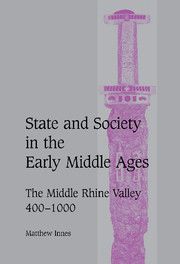Book contents
- Frontmatter
- Contents
- List of figures
- List of abbreviations
- A note on nomenclature and citations
- Acknowledgements
- Map 1 The Carolingian Rhineland
- Map 2 The Carolingian middle Rhine valley
- 1 INTRODUCTION
- 2 MONASTICISM, SPIRITUAL PATRONAGE AND SOCIAL STRUCTURE
- 3 LAND, KINSHIP AND STATUS
- 4 LOCAL POWER: COLLECTIVE ACTION, CONFLICT AND CONSENSUS
- 5 LOCALITY AND CENTRE: MECHANISMS OF EXTRACTION
- 6 POLITICAL POWER FROM THE FIFTH TO THE ELEVENTH CENTURY
- 7 CONCLUSION: STATE AND SOCIETY IN THE EARLY MEDIEVAL WEST
- List of primary sources
- Bibliography of secondary works
- Index
- Cambridge Studies in Medieval Life and Thought Fourth series
3 - LAND, KINSHIP AND STATUS
Published online by Cambridge University Press: 10 July 2009
- Frontmatter
- Contents
- List of figures
- List of abbreviations
- A note on nomenclature and citations
- Acknowledgements
- Map 1 The Carolingian Rhineland
- Map 2 The Carolingian middle Rhine valley
- 1 INTRODUCTION
- 2 MONASTICISM, SPIRITUAL PATRONAGE AND SOCIAL STRUCTURE
- 3 LAND, KINSHIP AND STATUS
- 4 LOCAL POWER: COLLECTIVE ACTION, CONFLICT AND CONSENSUS
- 5 LOCALITY AND CENTRE: MECHANISMS OF EXTRACTION
- 6 POLITICAL POWER FROM THE FIFTH TO THE ELEVENTH CENTURY
- 7 CONCLUSION: STATE AND SOCIETY IN THE EARLY MEDIEVAL WEST
- List of primary sources
- Bibliography of secondary works
- Index
- Cambridge Studies in Medieval Life and Thought Fourth series
Summary
THE ELITE: KINSHIP, LAND AND INHERITANCE
To explore the articulation of the interests of the elite through strategies of kinship, land and inheritance, I turn to the three families which we can examine in greatest detail. Their relationships with Fulda and Lorsch were so close that a series of well-focused images survive. The resulting family albums consist of carefully posed group portraits taken on a handful of important occasions. They need comparing and contrasting with the snapshots – often shaky and poorly focused – which can be snatched from a wide range of other sources. Then we may be in some position to generalise about the world of the elite. It should be underlined at the outset that what follows is not an exhaustive survey of important or influential families in the area, but an attempt to analyse the relationship between land, kinship and social status in the Carolingian middle Rhine.
LORSSCH'S FOUNDES
The first individuals on whom we can zoom in are the founders of Lorsch. The monastery founded at Lorsch in 764 was the successor of a nearby church which was likewise dedicated to St Peter and under the lordship of Chrodegang of Metz.
- Type
- Chapter
- Information
- State and Society in the Early Middle AgesThe Middle Rhine Valley, 400–1000, pp. 51 - 93Publisher: Cambridge University PressPrint publication year: 2000

